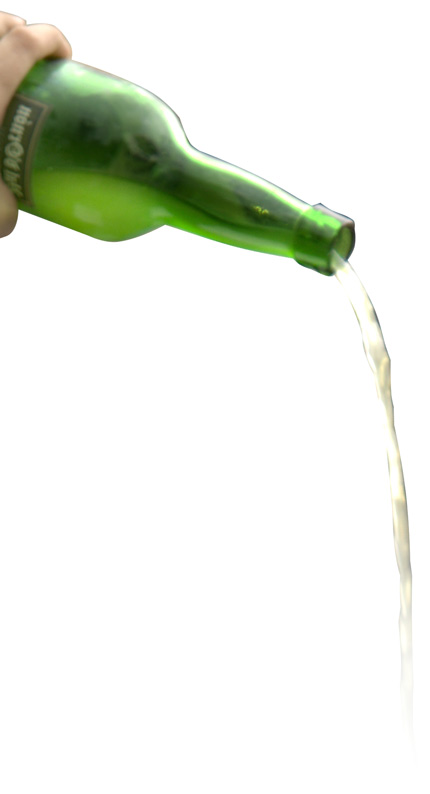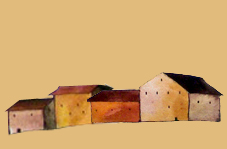 |
PINTXO:
Miniature Delights
The pincho in Gipuzkoa is not only the drink’s companion. There might be times when it was well- coupled with that concept. At present, it is a product with its own character, a ‘star’ in itself, an essential part of a popular custom that has become an exquisite tradition.
As the other mainstays in which the local gastronomy is supported, the pincho -also spelled pintxo- has undergone a notable evolution during the last years. We could even say that it reinvents itself year by year. In recent times, if we talk about the so-called haute cuisine in miniature we are speaking about creativity -with a capital C-, about sophisticated elaborations where the creative cuisine has become the main character of the most suggestive bars. Bars in which the diversity, the respect for the product’s primary flavour, and an elegant mise-en-scene prevail. The first choice among these delights in miniature is difficult, but even more difficult is the last one.
Moreover, if we are talking about pinchos, San Sebastián is an essential appointment. Gipuzkoa’s capital has been, and still is, the pioneer in innovating in this offer. Although the Old Quarter is the traditional excellence area when going to have some pinchos, the rest of the quarters -above all, Gros- and by extension the rest of Gipuzkoa’s territory, have been housing little by little many establishments where people worship everyday these delicious miniatures. Together with the ‘txikiteo’or ‘poteo’ -going from bar to bar or to have a few drinks-, the pincho has become a kind of collective liturgy in which this unique product turns Gipuzkoa’s capital into an exceptional place in the world due to its quantity and diversity, and also due to its undeniable quality.
There is a more and more fashionable attention and recognition of the gastronomic art in miniature. The pincho elaboration contests have become strong in Gipuzkoa. Likewise, these small ‘bites’ have their own place in all the fairs or congresses about gastronomy that enjoy an increasing attention. There go people from the catering sector and gourmets ready for delighting curious people and visitors with their inexhaustible talents of creation and good taste.
View pintxos bars and areas in Gipuzkoa
Texts from de http://www.gipuzkoaturismo.net/
|
 |
Cider and txakoli:
Autochthonous and with character
Cider and txakoli (Basque white wine) are the two Gipuzkoa’s drinks par excellence. Cider -sagardoa in Basque- has a flavour between acid and sweet, and is mainly elaborated in Astigarraga and Usurbil. On the other hand, txakoli is mostly produced in Getaria, Zarautz and Aia. As both are new drinks, it is recommended to consume them during the season in which they have been bottled. Centuries ago, cider was elaborated in the farmhouses as a drink for their own consumption. The traditional elaboration -between October and November- starts with the selection of the apples. These are introduced into the tolare -press- and the liquid is poured into the kupelas -wooden casks-. After three months of fermentation, cider is ready for being tasted. Tradition says that, formerly, the customers of bars, restaurants, or gastronomic societies visited cider bars to taste the product that was stored in the kupelas and to select it for being bottled. The customers usually carried their own casseroles with some fish with sauce, as well as some cod omelette and cutlet that they braised there, so that the successive tastings did not affect their stomachs. All this turned to the modern menus of the cider bars, where the typical dessert is Idiazabal cheese with local nuts, sometimes accompanied by quince jelly. If you go to Gipuzkoa between January and April, you will be able to enjoy the txotx season -tasting the cider directly from the casks- in some of the many cider bars, where besides good food, you will enjoy a great atmosphere. Most of the cider bars are gathered in the municipalities of Astigarraga, Hernani and Usurbil. Although in many of them we are sitting in long benches -it is usual to share the tables-, there are still some places where the menu is tasted standing up, in the old-fashioned way. Txakoli, many time considered as a “poor wine”, has shot up its consumption during the last years. The Denomination of Origin Getaria’s Txakoli-Getariako Txakolina offers a young wine elaborated with two different grape varieties: the Hondarribi Zuri -85-90 % of the production- and the Hondarribi Beltza. It is a white wine, young, straw-coloured, with fruit scents, of an average alcoholic strength of 10,5º, and with a slight characteristic sourness. The grapevine harvest is made between September and October. It is an excellent companion for fish and shellfish and, when it comes to serve it, it is recommended to break it in the glass to give off all its range of scents, like cider.
Wineries sidrearías txakoli and guidance in Gipuzkoa
Texts from de http://www.gipuzkoaturismo.net/
|
 |
Quality K
The production and consumption of quality products has experienced a spectacular boom during the last years in Gipuzkoa. Traditional fairs and markets, ‘delicatessen’ shops and even superstores reserve space for this type of products.
When we talk about quality foods, we refer to those food and agriculture products that are distinguished for having overcome the medium quality criteria established for the market. With this certificate of quality ‘K’, the origin and the authenticity of a series of products is guaranteed, which benefits both the producers and consumers.
In Gipuzkoa and in the rest of the Basque territories, the foundation Kalitatea Fundazioa is in charge of regulating and controlling the certification of the different products.
This institution comprises different sections within the existing quality products. Besides those included in the certification ‘Eusko Label’, for example beef and veal, farmhouse chicken, young lamb, high quality pasteurised milk, tomato, honey, Ibarra red chillis, beans, Euskal Baserri (Basque Farmhouse); there are other food of ‘Ecological Agriculture’ and the products with Denomination of Origin – Getaria Txakoli and Idiazabal Cheese-.
Idiazabal cheese
Eusko Label Products
Texts from: http://www.gipuzkoaturismo.net/
Foto: Scott Bauer
|
 |
Gastronomic Fairs:
The best showcase
The markets and food and agriculture and livestock fairs celebrated all the year round in Gipuzkoa have the characteristic that they largely put in touch people from the urban and rural settings. These days become a great platform to show the quality of our local products. More than 100 events of these characteristics take place in Gipuzkoa throughout the year, most of them between August and December.
Among the strong appointments in the festive and gastronomic calendar, the markets of Ordizia and Tolosa stand out due to their weekly activity. The Wednesday market in Ordizia serves as a reference for the rest of the province. The prices set for the agricultural products also become the reference for the rest of the province and for the entire Basque Country during that week.
Besides the ordinary market, Ordizia celebrates several special markets every year, such as the outstanding Basque Feasts in September and the famous Contest of Latxa Sheep’s Idiazabal Cheese, as well as the Christmas Special Market.
On the other hand, Tolosa also organises many special fairs with a great success of visitors: the Tolosa Goxua (confectionery fair), the Beer Fair, or the Gastronomy and Bean Fair.
Other important dates in the annual calendar of Gipuzkoa’s fairs and Markets are the Urte Berri in Deba, the Txakoli Eguna or Txakoli Day in Getaria, the Sagardo Eguna or Cider Day in Donostia, the Santa Lucía Fair in Zumarraga and Urretxu, the Santo Tomás Fair in Donostia or the Gabon Zahar in Elgoibar.
Food fairs calendar
Texts from: http://www.gipuzkoaturismo.net/
|





